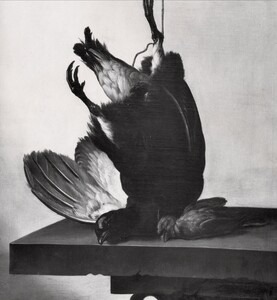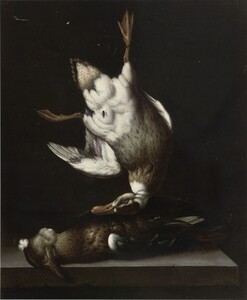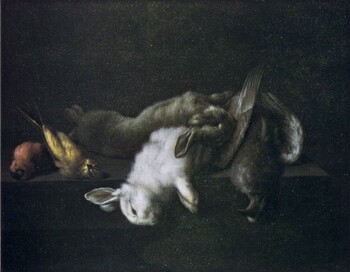5.300 €
Hunting still life with a pheasant and four songbirds
Oil on canvas : 75,7 X 62,9 cm
Signed bottom right “J.v.Hagen F”
(the F for Fecit stands actually a line lower”)
Currently unframed
Provenance : sold at Christie’s London, 19/05/89 for 3.300 £ = 5.508 €
About Jacobus van der Hagen
Dutch painter
The Hague 1657 – 1715 The Hague
Rare painter of trompe l’oeil game still lifes. There is also a signed fish still life known.
There reigns confusion with Jacob Verhagen, a still life painter who is documented in Haarlem (1666 and 1673) and in his birthplace Dordrecht (1680). He specialised in impressive fruit still lifes on a silver or porcelain platter with a Roemer glass in front of a niche. Although he signed his works “I:Verhagen” he is often mistakenly called Jacobus van der Hagen, like our painter.
Our Jacobus van der Hagen was the son of the landscape painter Joris I van der Hagen (Arnhem 1615 – 1669 The Hague), who had settled in The Hague in 1639. Joris passed away when Jacobus had the age of eleven. Jacobus was first trained as a tailor, but soon learned to paint, probably under his little-known elder brother Cornelis (1651 – 1690), who had been a pupil of their father.
His main artistic aim was to deceive the eye of his public. He skilfully painted the plumes of birds hanging from a nail or lying on a ledge.
About the art of painting a “trompe l’oeil”
A “trompe l’oeil” is a game, a joke, a cheating device. Painting also: how can a painter represent in two dimensions the effect of depth, of a third dimension?
That makes the study of 17th century painting in the Low Countries so interesting: one witnesses the invention of new subjects, new techniques. How far would these painters go in playfully excelling in their art? How refined could culture get? Painters turned art into a game and a game into art.
These paintings were called “bedriegertjes”, that is “a small imposter, a small crook”. Their aim was not only to deceive by perfectly imitating the objects, but also to be identified as painted fiction.
Why should you buy our painting?
Because it is an ode to painting, the ultimate art of deceiving.
Because it looks so modern, having been painted against a clear background.
Comparative paintings
Click photos for more details



